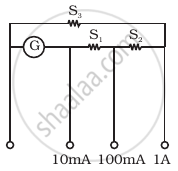Advertisements
Advertisements
प्रश्न
Increasing the current sensitivity of a galvanometer may not necessarily increase its voltage sensitivity. Explain, giving reason.
उत्तर
The current sensitivity of a moving coil galvanometer is given by `(nBA)/k`, where n is the number of turns , A is the area of the coil , B is the magnetic field strength of the poles and k is the spring's constant of the suspension wire.
Similarly, voltage sensitivity is given by `(nBA)/(kR)`, where R is the resistance of the wire.
From the above two expressions, we get:
Voltage sensitivity = Current sensitivity/R
Thus, on increasing the current sensitivity, voltage sensitivity may or may not increase because of similar changes in the resistance of the coil, which may also increase due to increase in temperature.
APPEARS IN
संबंधित प्रश्न
A galvanometer of resistance G is converted into a voltmeter to measure upto V volts by connecting a resistance R1 in series with the coil. If a resistance R2 is connected in series with it, then it can measures upto V/2 volts. Find the resistance, in terms of R1 and R2, required to be connected to convert it into a voltmeter that can read upto 2 V. Also find the resistance G of the galvanometer in terms of R1 and R2
Draw a labelled diagram of a moving coil galvanometer. Describe briefly its principle and working.
Two moving coil meters, M1 and M2 have the following particulars:
R1 = 10 Ω, N1 = 30,
A1 = 3.6 × 10–3 m2, B1 = 0.25 T
R2 = 14 Ω, N2 = 42,
A2 = 1.8 × 10–3 m2, B2 = 0.50 T
(The spring constants are identical for the two meters).
Determine the ratio of
- current sensitivity and
- voltage sensitivity of M2 and M1.
A moving coil galvanometer has a resistance of 25Ω and gives a full scale deflection for a current of 10mA. How will you convert it into a voltmeter having range 0 - 100 V?
What are the advantages of using soft iron as a core, instead of steel, in the coils of galvanometers?
A coil of radius 10 cm and resistance 40 Ω has 1000 turns. It is placed with its plane vertical and its axis parallel to the magnetic meridian. The coil is connected to a galvanometer and is rotated about the vertical diameter through an angle of 180°. Find the charge which flows through the galvanometer if the horizontal component of the earth's magnetic field is BH = 3.0 × 10−5 T.
In an ammeter 0.5% of main current passes through galvanometer; If resistance of galvanometer is G, the resistance of ammeter will be.
A multirange current meter can be constructed by using a galvanometer circuit as shown in figure. We want a current meter that can measure 10 mA, 100 mA and 1A using a galvanometer of resistance 10 Ω and that prduces maximum deflection for current of 1mA. Find S1, S2 and S3 that have to be used

How is current sensitivity increased?
A moving coil galvanometer of resistance 55 Ω produces a full scale deflection for a current of 250 mA. How will you convert it into an ammeter with a range of 0 - 3A?
